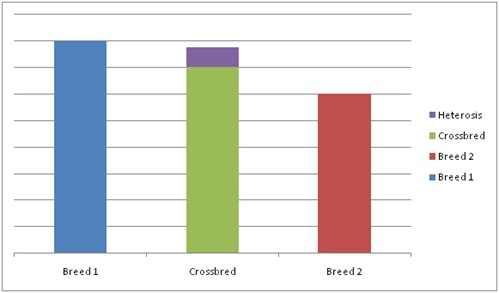- Home
- Dairy genetic crossbreeding
Dairy genetic crossbreeding
Crossbreeding is the deliberate mating of animals from different breeds or strains designed to take advantage of Heterosis (Hybrid Vigour) for characteristics like production, fertility and longevity.
Heterosis/Hybrid Vigour is the tendency of a crossbred animal to have qualities superior to that of either parent but not more than the dominant breed.
The graph shows how heterosis can be applied to all health or production traits if there is sufficent genetic difference between the two chosen breeds.
If Breed 1 was crossed with Breed 2 the green area of the crossbred would be the logical average animal produced by the two breeds. The purple area on top of this is the added benefit or heterosis effect. The heterosis effect is variable between breeds and also the traits affected.

Trial work has shown the main benefit of heterosis is seen in fitness and health traits. 10% to 18% heterosis has been recorded in trials carried out in California and New Zealand in a wide variety of crossbred cows including Swedish/Norwegian Reds (SRB), Brown Swiss, Jerseys, and Montbelliarde. Milk production has been recorded as improving up to 6% but it is important to remember this is not the only measure of profitability.
To gain and maintain the effects of heterosis, breed and bull selection is paramount. To maximise the benefits farmers need to plan the direction they want their business to take in the long term to ensure cross breeding is the right path for them.
The £SCI and £ACI are designed to make selecting sires for cross breeding easier. Farmers who are spring or autumn-block calving should use these as initial filters to compare all bulls of interest then narrow down on the traits they wish to improve within their herd. The £ACI should be used by all year round farmers looking to cross breed.
|
2 Way Cross |
67% |
|
3 Way Cross |
85% |
|
4 Way Cross |
94% |
Although working a four way cross system provides maximum gain from heterosis, it is widly recomended a three way cross is more sustainable. Using a four way cross is:
- Difficult to implement
- Choosing four suitable breeds can be a problem
- Breed qualities are watered down with each cross
Heterosis should not be used as the main reason to crossbreed but as an added bonus. It is important to remember that crossbreeding is about herd improvement not breed improvement.

